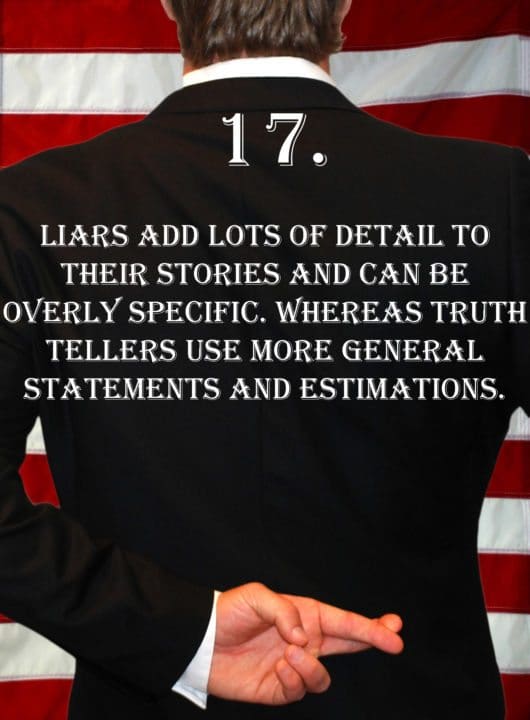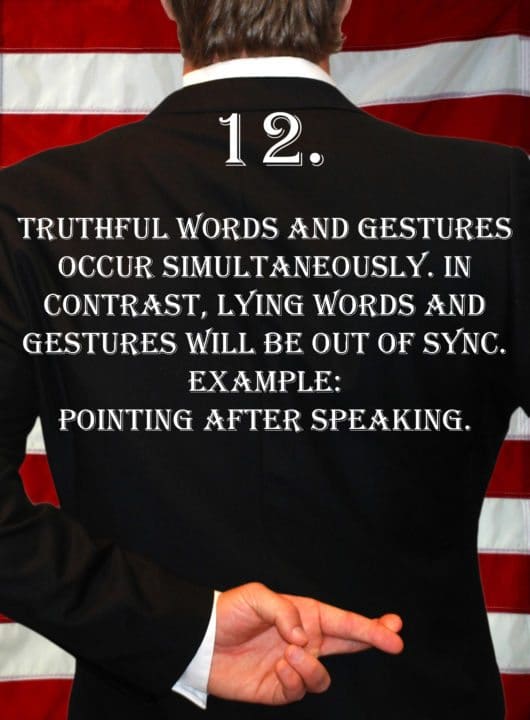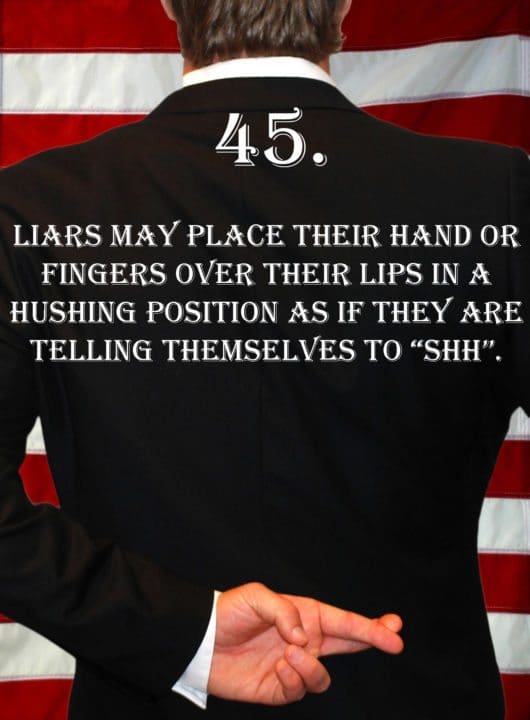
Deception Tip 17:
Liars add lots of detail to their stories and can be overly specific. Whereas truth tellers use more general statements and estimations.
Listen To The Podcast!
E17 – Detailed Stories – Deception Tips Podcast – Click Here To Subscribe
Podcast Transcript
Hello, and welcome to the Deception Tips Podcast, where you will learn amazing cues to detect deceit that will help you read people like never before. I’m your host, Spencer Coffman. Let’s get started.
Welcome to episode 17 of the Deception Tips Podcast. Last time, we talked about symmetrical gestures and how body language is often symmetrical at least truthful body language.
So, when people are doing things with their hands, or shrugging their shoulders, etcetera, you expect it to happen the same on both sides of the body. So, if someone thinks they don’t know the answer and they shrug their shoulders, they’re going to shrug both shoulders together. If they turn their hands upward, both hands are going to go upward and it’s going to be a complete cluster of gestures that happen symmetrically on both sides of the body.
However, if someone is lying or if they are saying something and they don’t believe what they’re saying- like they have no confidence in what they just said, you’ll tend to see a one-sided shoulder shrug or asymmetrical gestures.
Such as, if someone claims, “Oh yes! Our stock prices are going to go up!” A big business CEO or something like that. And, he may say that and one shoulder will go up. That tells you he has no confidence in what he just said. Stock prices are not going to go up. They’re going to go down.
So, most of the time, when people have asymmetrical gestures they are going to be lying. And this is the same with expressions on the face. We talked about that in episode 14 with emotions being displayed on the face.
Predominantly, smiles are largely symmetrical. And so, when things happen, things like smiles, surprise, any of these micro-expressions, you expect them to happen on both sides of the face. If, however, they don’t, that could be a deceptive gesture.
Now, be sure to watch for these more on the left side of the face than the right side because the left side of the face is controlled by the right cerebral hemisphere which is more predominant in false emotions.
Remember we also talked about simultaneous gestures which is another form of symmetricality between speech and body language. We did that in episode 12 and that is like when people point and talk, or when they hit the table and talk, their gestures are going to mirror or be in synchronization with the words that they’re saying. You expect them to match up. There needs to be some symmetricality there.
So, the bottom line with all of this is that truthful speech, body language, emotions, speech, and body language all need to be symmetrical. Everything has to be in unison. Cohesive. It happens together. It happens naturally and it looks like it belongs.
If ever you see something that is not symmetrical, or asymmetrical, then you can start to question whether or not that is a deceptive behavior or if that person is lying, or if they simply don’t believe what they’re saying. But, the point is that something is fishy about that. Something is off.
So, today we are going to talk about another form of lying. This is more of a tactic that you can use, but it’s also something that you’ll have to learn to realize. Sort of like when we talked about staying silent because liars are going to continue to talk to fill the void. And rehearsed stories, about how liars rehearse them in order instead of backward. So, it’s kind of a trick you can use.
This one is about how liars will continue to tell their story and add more detail. Because usually, as we talked about when they’re going to continue talking to fill the gap, how they are trying to not only convince the target of their lie, but they are also working really hard to convince themselves of the lie.
Even though they may have rehearsed it and planned it, they’re still trying to talk themselves into it. They’re selling the target and they’re selling themselves on that lie. As a result, they’re going to continue to add a lot of detail to these lies and that is the tip we are going to talk about today.
So, here it is. Deception Tip 17: Liars add lots of detail to their stories and can be overly specific. Whereas truth-tellers tend to use more general statements and estimations. Here it is again. Liars add lots of detail to their stories and can be overly specific. Whereas truth-tellers use more general statements and estimations.
Liars are trying very, very hard to convince people that their story is true. They are also trying very, very hard to convince themselves. As a result, they will use detail- abundantly- to try to convince and put all that stuff together so that it sounds more believable. What they don’t realize is that most people don’t remember all of this detail.
So, for example, a liar may say, “Yeah. I went to the market and I remember there was a tree that broke. And it was down on the side of the road there from the storm last night and that was probably at around 3:45. And then when I got to the supermarket, that was about 4 o’clock and I went down aisle 27 and I had to ask somebody where the powdered sugar was. And, at that point, I went over and got some baking soda and the powdered sugar of course.”
And you see there is a lot of detail in their story. And it doesn’t really sound normal because no one really talks with that much detail. We don’t care about “aisle 27.” We don’t care what time it was. Most people don’t remember specific instances unless they’re establishing an alibi or unless they’re telling a lie and trying to make it sound more true than it really is.
A typical, truthful story would have been something like, “I was driving to the supermarket the other day and I saw there was a tree down on the side of the road from the storm last night. I didn’t really think about it. There was a lot of damage. I guess it was a pretty big storm.
But anyway, I got to the supermarket and then I had to ask someone where the powdered sugar was because I didn’t know. So, then I got that and also some baking soda. And I suppose that was at about at like 4 o’clock or so.” That’s a more normal story. It was kind of quick told, jumbled up a little bit. It wasn’t necessarily in perfect order. It was more of a narrative.
Memory is imperfect. Remember that. And when people remember stories, and they tell them from memory, they often forget and miss certain little details that they come back to. And then, of course, as we talked about, if you have them tell it backward, they’ll sum it up even shorter and remember it backward and may even be a little bit irritated about it.
So, remember, that’s a great tactic for you to use when you’re trying to determine whether or not someone is telling the truth along with all the other tactics that we’ve come up with and all the signs you’re paying attention to.
So, how can you see this? How can you learn to recognize when people are using too much detail and when they’re using not enough? Or when a lying statement is actually lying with the amount of detail that they use. We will talk all about this, coming up. Right after this.
How about having a handy guide filled with quick tips to detect deception? Now you can. Deception Tips is an e-book with 101 cues to detecting deception. Grab your copy today at spencercoffman.com or any major retailer.
Liars often add way too much detail to their stories when they are trying to tell a story to establish their innocence, their whereabouts, some form of alibi, whatever. They tend to use a lot of specifics and they will often refer to times, places, and people that they were with.
But it depends also on the type of lie because sometimes they may not include any people because they’ll be worried that you’re going to check and they’ll ask those people. Or if they have people that are covering for them, then they’ll include those people only.
Usually, when someone truthful tells a story, it is a random assortment of data due to the imperfection of our memory. We don’t remember things exactly as they happened. You can test this out yourself. Get an object. Anything. Say a brown chair.
This is my favorite thing to do when looking at memory and how people tell stories. And you can do this with anything. Take any object. Have five people look at it. Then have those five people on a piece of paper to describe that object. You will get five different descriptions of that object.
In addition, remember that game called “Telephone” where you sit in a circle and someone starts out with a phrase, and by the time it gets to the end, it’s usually drastically different because of the interpretation that goes around the circle? People really don’t have it put together properly. Memory is imperfect.
So, when you’re telling a story, or someone is telling something that happened, they’re going to tell it in an imperfect way. It’s not going to be exactly as the events unfolded. The detail is going to be missing. Some events are going to be missing.
In some instances, people- they’re not going to remember all of those things. Like, what it sounded like, what it smelled like, what they thought about. Those are things that you have to prod and probe for.
And, oftentimes, they have to shut their eyes or sometimes they even put them in a hypnosis type doctor who gets them to relax and think about it and kind of travel back there and, “Ok. Now tell me what you’re seeing. Tell me what you’re smelling. Tell me what it looks like. What does it feel like? What are the sounds there? How is the air? Is it wet? Is it dry?” They kind of walk them through all of this stuff to help them bring back their memory.
Whereas a liar, they have all that in their story. They talk about, “Well when I was walking I felt the leaves crunching under my feet. And this, and this…” and they bring out all these details. And so, when someone is telling you a story, and the details are so vibrant and so rich that it sounds like a novel like you’re reading a book, then you know, it’s probably fiction.
Why? Well, because in books the authors, especially fiction authors, do a good job of painting a picture. They want you to be able to see everything in your mind. They are probing your imagination.
So, oftentimes, in a fiction book, they say, “The trees looked like they were quaking in the wind. I saw the soft petals of the flowers swaying with the breeze. I felt the cold air kiss my face…” and on and on.
They use a lot of adjectives and adverbs and a lot of descriptions to get you to live and feel that. They want you to believe that you are right there in the story. And so, when someone is lying, they often use these details as well unconsciously because they think it adds credibility and truth to their story.
They want you to believe them. They want you to feel like you are there in their story and that you’ll accept it. It makes sense because, if I’m telling you a story and I use a lot of detail and I get your imagination going, now you start believing my lie because you start getting invested.
You start to reason in your brain, in your imagination, how it could actually be a possibility. How it could actually happen. You see it and you start to live that fantasy. Whereas when someone tells the truth, those details are not present, yet it’s accepted more in a natural conversation because you know in your unconscious that that’s how people talk.
When people tell stories, oftentimes, a lot of things are missing. It’s just tough to understand them. So, when you’re asking- like in an interrogation, for example- the person runs by their scenario. “Yeah. Yesterday, I walked to the park. On the way, my dog got into a fight with another dog and that’s how he got bit on the ear.”
Well, what about all the other things? What was the weather like? What time did you go to the park? How did the air smell? Was there blood from the fight that the dog got bit? Did they fight for a long time? What kind of dog do you have? What kind of dog does the other person have? Who was walking the other dog? Was it loose? Was it on a leash? All of these details are missing from that story. Yet, that could be a truthful story. It probably is. That’s how a truthful story would sound.
However, if someone said, “Yeah. Yesterday, at about 3 o’clock I walked down to the park with my dog Fido and he’s a spring terrier. And we were walking and we went past the garbage cans, and then the bench, and there was a lady sitting with her dog and she had a pit bull. And its name was Doberman.
It was kind of a funny scenario and that dog started growling at mine, and then mine barked. And, then that one bit my dog in the ear. And there was some blood and it was bleeding but there’s really not a lot of blood in the ear, so it was kind of weird, so now it just looks like he’s got a pierced ear.” That story has way too much detail for it to be true. It was kind of something that you have to concoct and think of.
And, oftentimes, you’ll see this with kids. When kids tell stories and kids tell lies, they use a lot of details. And, it’s funny because kids are so suggestive and impressionable. They’re like little sponges.
So, when they’re telling a lie or a story, oftentimes- this works super well- you can suggest details to them and they’ll agree with it. “Oh yeah! And what happened? Was the dog’s collar did he have a blue collar?” “Yeah. He had a blue collar.” “Oh cool! Was it a green leash?” “Yeah. The leash was green.” You can give them these details and they’ll continue to add them to their story and the story will grow, and grow, and grow. We call those ‘fish tales.’ They get really long.
And, that is similar to certain tips that we’ve talked about before. Like episode 11 when we talked about accepting lies. Oftentimes, they’ll accept those lies and put them in as part of their story.
Liars like to use those things to help build because they think that you are believing their lie. When you start suggesting details they start thinking that you are believing their lie and they’ll continue to run with it as far as they can.
So, remember that liars often use way too much detail. And, as a method of helping you to determine whether or not they are using too much detail and it’s a lie, or whether it’s just an anal-retentive person that likes a lot of detail or an OCD person who likes a lot of detail, is use some other methods to suggest other tactics. Suggest certain details to them. In addition, keep an eye out for other signs of deception and other patterns/clusters, etcetera.
I want to thank you for listening to this week’s episode of the Deception Tips Podcast. I encourage you to share it with your friends, subscribe to the feed, follow the Deception Tips Blog, and take a look at the books I have available. And, as always, tune in next week for a new Deception Tip.
Video Transcript
Hey, guys, my name is Spencer Coffman. Thank you for watching the Deception Tips videos. They’re all about teaching you how to read people and detect deception so that you will be able to tell if someone is lying to you.
Today we are going to talk about a really neat thing about deception, and it’s about liars and how they tell their stories, what they use. Usually, when someone is lying, they tend to use a lot more detail, because they think that this detail will be more believable. They’ve rehearsed their story. So this would be typically for rehearsed lies and planned stories, which as we’ve talked about before, is more narratives and linear stories, so if you remember we had another tip about that, you could get them to tell it backward and often times they would be unable to do so because they rehearsed it in order.
So typically, as a part of this rehearsal, something that could kind of give you an idea that what they’re telling you is rehearsed, as if they’ve added a lot of detail. And now, a lot of detail meaning specific things, like at whatever time, if they say, well, most people would talk about just a general time. If they have a specific time, or if they have specific things, or exactly what someone was wearing or exactly what someone did, those types of things are not normal for people to recall naturally, and usually, that could indicate part of deception.
So here it is, this is deception tip 17, Liars add lots of detail to their stories and can be overly specific. Whereas truth tellers use more general estimates and statements.
They are usually very, very detailed. Liars love to inject all this detail because as they’re planning out their story, and as they’re rehearsing it, They say, “okay, well, I need to make sure that they’re going to believe me.” That is their number one goal. A liar wants to be believed. And they want to get the story out.
This is an incredible amount of stress and tension inside their body. It’s like boiling up. They’re a tea kettle waiting to blow. And, or a balloon that’s overfilled with air, and they just need someone to pop it. When that happens, they want the story to be out. So they want this to be as believable as possible, so hopefully, they only have to tell it once. Because a lot of times liars, if they’re asked to tell the same story over and over again, they can’t remember it. So that’s another way to trip them up.
You can just call him back in a day later and ask him to tell the story again, and usually if, if there is a truth, then usually people kind of forget certain things, or they may tell it in a different order, but if it’s a liar, and it’s reversed, it might be the exact same story. Which could be a little bit off, and we’ll come to that another time. However, they inject a lot of detail.
So normally like, if I would tell you a story, and say, “well yeah, yesterday I took a drive down to the grocery store and I went down the aisle, and I had to ask this guy, he was kind of a teenage kid, and asked him where the mayonnaise was, and he didn’t really know, so we had to go find another guy who had worked at the store for 10 years, and he knew right where was. Exactly where, in what aisle, and also on what shelf, and even wanted to know what brand I wanted, because then he would know on which shelf that brand would be.”
And so, that is kind of just a general story. However, if it was a lie, then it could say, “well, I got in my car at 4:05 and I drove to the grocery store. That maybe took me about 4 minutes. When I got in there, I asked this kid, he was wearing a red shirt and khaki pants, and I wanted to know where the mayonnaise was, and he didn’t know where the mayonnaise was, so he said we had to go find this guy named Bruce, who had been working at the store for 10 years and 3 months.”
And you get the idea, there’s a lot more detail in that story, and it just kind of sounds weird. Like, who cares about what time it was, and who cares what the guy’s name was? I just want the general idea of the story, I don’t need every single detail.
So when liars rehearse their stories, oftentimes they add in all of those details because they think it’s more believable. They think that they are, by telling everything, they believe that the target is going to say, “wow, they’re really opening up to me. They’re really sharing all the information. So why would I doubt them, because they told me all this information?”
But in reality, that’s not the case, because they’re over-emphasizing this fact. It’s kind of like when they split contractions and say, “I did not”. They’re over-emphasizing the events. So by including all of that detail, they’re adding extra emphasis that doesn’t need to be there, and that is not normally there when people tell a story. So truthful people will be more general, they will have more general stories.
In addition, they often will forget certain things, and say, “oh, well wait a minute, actually before we went and asked the other guy, we tried to find it in a different aisle, but he didn’t find it, so then we had to go ask another guy.” That would be more truthful. They, they come back to things as they remember them in the story. Whereas liars, it’s like the ABC’s. Everything is planned out, rehearsed, it’s a narrative order, it’s one thing, then the next, it’s a natural progression.
Now, of course, a liar could see this and then manipulate their story to purposefully come back and add something in that they wanted to forget, to try to come more truthful, but typically, then they’re going to have all kinds of behavioral leakage that goes with that, so you’re gonna catch it anyway. So keep in mind, watch for that. Lateral narratives with lots of detail could be a sign of deception. In addition, there are a lot more signs that you can watch for and pay attention to.
If this is your first time watching these videos, I would love to have you subscribe to the channel on YouTube. If you have any questions, feel free to Comment on them as well. Also, if you’d like more information, we’ve got books, podcasts, blog posts all available on SpencerCoffman.com that are dedicated to teaching you exactly what every body is really saying.
Until next time.






